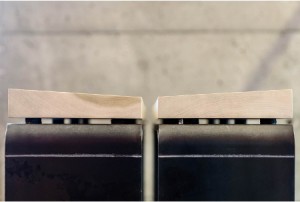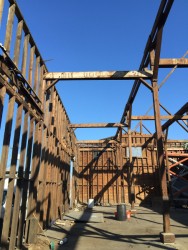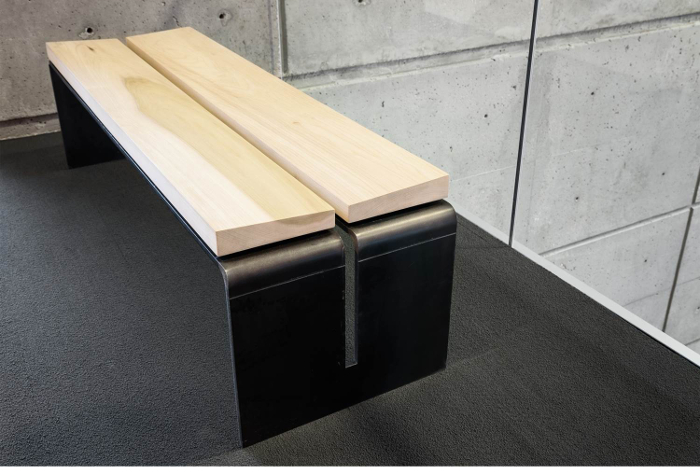So Much More Than a Place to Sit
UNL benches made from 19th-century wood—in an HDR design principal’s garage
 What do an Omaha former recycling center, four private residences, two office buildings, a restaurant—and now Manter Hall on the University of Nebraska-Lincoln’s campus have in common? Douglas Fir dating back 200 years.
What do an Omaha former recycling center, four private residences, two office buildings, a restaurant—and now Manter Hall on the University of Nebraska-Lincoln’s campus have in common? Douglas Fir dating back 200 years.
Reclaiming and repurposing the wood is so much more meaningful than buying it from a hardware store, says Mike Hamilton, HDR Omaha design principal. So far, the wood has been used to make tables, a hostess stand, stairs and even earrings.
“It gives the project an inherent story,” he says. “It has a history—a legacy. It shows how what we use in architecture can be more meaningful.”
Mike is turning 150 linear feet of the Douglas Fir rafter ties and hot rolled steel into 12 benches for a new student-centered circulation space in UNL’s School of Biological Sciences building. Currently a narrow, “drab and mundane” corridor, Mike says, students have to sit on the floor, which was the impetus for the bench project. They will be installed this fall as part of an HDR $6 million, 30,000-square-foot renovation of Manter Hall’s biology labs and student and administrative space.
“This entire project is going to dramatically transform the student experience in Manter Hall—adding modern teaching facilities, lots of natural light and the kind of space that students will want to spend time in,” says Valery Forbes, director of UNL’s School of Biological Sciences. “And I love the benches! Their clean lines and functionality, combined with the biological and historical stories they tell, are perfect for the new space.”
Mike’s own garage has become a work site, where he has been fabricating the benches for the past eight months. Reclaiming/recycling/upcycling for almost 20 years as a hobby, his many projects have included repurposing the former Ranch Bowl’s bowling lanes into flooring for his home.
It’s fitting that the benches will be in a science building, Mike says, since the wood can be used as a teaching tool. Its imperfections and growth rings—some pieces have more than 30 growth rings per inch—help tell the story of climatic changes during the life of the tree.
 This story began in the northwestern United States, when carpenters hand-wrote the dates “July 1890” and “December 1900” on pieces of Douglas Fir. The wood made its way to south Omaha, where it was used to construct a 5,000-square-foot wood building with a hay loft, according to Jason Gilbreath of Reclaimed Enterprises. Jason found the dates on the wood, in addition to an embossed wood sign that said “No Smoking in Hay Area” during the deconstruction process.
This story began in the northwestern United States, when carpenters hand-wrote the dates “July 1890” and “December 1900” on pieces of Douglas Fir. The wood made its way to south Omaha, where it was used to construct a 5,000-square-foot wood building with a hay loft, according to Jason Gilbreath of Reclaimed Enterprises. Jason found the dates on the wood, in addition to an embossed wood sign that said “No Smoking in Hay Area” during the deconstruction process.
The building was later used for a can recycling center, and then most recently for storage. When the foundation began to buckle, it was decided to turn the land on which the building stood into a parking lot—but not before Reclaimed Enterprises salvaged 95 percent of its wood and other materials this past spring.
“We thank him for that,” Jason says about the building’s owner, who chose to deconstruct the building rather than demolish it.
Students are already using a bench prototype in Manter Hall.
“I get to be part of a team bringing life to a space,” Mike says. “It’s part of why I love what I do. People will get to enjoy this space.”
About HDR
At HDR, we are committed to design excellence and innovation. By employing a highly participatory and collaborative design process, our team of talented professionals creates architecture that is both proud and humble, stays true to its purpose, and creates a sense of place that is meaningful to the society it serves. Learn more at www.hdrinc.com or follow us at @HDRArchitecture
HDR has partnered with clients to shape communities and push the boundaries of what’s possible since 1917. We specialize in engineering, architecture, environmental and construction services. With nearly 10,000 employees in more than 225 locations around the world, we think global and act local.
Reclaimed Enterprises sells reclaimed materials, found items and products built from reclaimed materials from buildings dating back as far as 1890. Custom furniture can also be purchased through the website at reclaimedenterprises.com or at 1445 N. 11th St., Omaha, NE 68102






